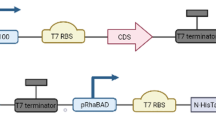Abstract
Rhodopseudomonas palustris was selected for the ability to grow in diglycosylated flavonoids-based media, exhibited deglycosylation activity. The present study aimed to investigate the ability of a crude enzyme from Rhodopseudomonas palustris to transform rutin. Our results showed the crude enzyme was found to transform rutin to quercetin via isoquercitrin. The maximum enzyme activities were observed at pH 7.0, 25 °C, and rutin concentration of 1.0 mg mL− 1. Under optimal conditions, 13.11 μM rutin was biotransformed into 6.86 μM isoquercitrin and 11.64 μM quercetin after 11 and 21 h, respectively. The study demonstrates an eco-friendly and potential economically viable ‘green’ conversion route to convert rutin to isoquercitrin and quercetin, which is of great interest, considering the therapeutic applications of isoquercitrin and quercetin. The specific biotransformation of rutin to isoquercitrin and quercetin, using the crude enzyme from Rhodopseudomonas palustris, may potentially serve as a new method for industrial production of isoquercitrin and quercetin.






Similar content being viewed by others
References
Chua LS (2013) A review on plant-based rutin extraction methods and its pharmacological activities. J Ethnopharmacol 150:805–817. doi:10.1016/j.jep.2013.10.036
Tang DQ, Wei YQ, Gao YY, Yin XX, Yang DZ, Mou J, Jiang XL (2011) Protective effects of rutin on rat glomerular mesangial cells cultured in high glucose conditions. Phytother Res 25, 1640–1647. doi:10.1002/ptr.3461
Amado NG, Fonseca BF, Cerqueira DM et al (2012) Effects of natural compounds on Xenopus embryogenesis: a potential read out for functional drug discovery targeting Wnt/β-catenin signaling. Curr Top Med Chem 12(19):2103–2113. doi:10.2174/1568026611212190008
Zhang R, Yao Y, Wang YP, Ren GX (2011) Antidiabetic activity of isoquercetin in diabetic KK-Ay mice. Nutr Metab 8(1): 1–6. doi:10.1186/1743-7075-8-85.
Kim Y, Narayanan S, Chang KO (2010) Inhibition of influenza virus replication by plant-derived isoquercetin. Antiviral Res 88(2):227–235. doi:10.1016/j.antiviral.2010.08.016
Gasparotto A, Gasparotto FM, Boffo MA et al (2011) Diuretic and potassium-sparing effect of Isoquercitrin-an active flavonoid of Tropaeolum majus L. J Ethnopharmacol 134(2):210–215. doi:10.1016/j.jep.2010.12.009
Li RJ, Yuan C, Dong C, Shuang SM, Choi MMF (2011) In vivo antioxidative effect of isoquercitrin on cadmium-induced oxidative damage to mouse liver and kidney. Naunyn-Schmiedeberg’s Arch Pharmacol 383(5):437–445. doi:10.1007/s00210-011-0613-2
Wang XH, Schröder HC, Feng QL et al (2014) Isoquercitrin and polyphosphate co-enhance mineralization of human osteoblast-like SaOS-2 cells via separate activation of two RUNX2 cofactors AFT6 and Ets1. Biochem Pharmacol 89(3):413–421. doi:10.1016/j.bcp.2014.03.020
Russo M, Spagnuolo C, Tedesco I, Bilotto S, Russo GL (2012) The flavonoid quercetin in disease prevention and therapy: facts and fancies. Biochem Pharmacol 83(1):6–15. doi:10.1016/j.bcp.2011.08.010
Bischoff SC (2008) Quercetin:potentials in the prevention and therapy of disease. Curr Opin Clin Nutr Metab Care 11(6):733–740. doi:10.1097/MCO.0b013e32831394b8
Wang J, Zhao LL, Sun GX et al (2011) A comparison of acidic and enzymatic hydrolysis of rutin. Afr J Biotechnol 10(8):1460–1466. doi:10.5897/AJB10.2077
Hyun-Koo Nam, Seung-Hye Hong, Kyung-Chul Shin, Deok-Kun Oh (2012) Quercetin production from rutin by a thermostable β-rutinosidase from Pyrococcus furiosus. Biotechnol Lett 34:483–489. doi:10.1007/s10529-011-0786-2
Imhoff JF, Trüper HG, Pfennig N (1984) Rearrangements of the species and genera of the phototrophic “purple nonsulfur bacteria”. Int J Syst Bacteriol 34:340–343. doi:10.1099/00207713-34-3-340
Larimer FW, Chain P, Hauser L, Lamerdin J et al (2004) Complete genome sequence of the metabolically versatile photosynthetic bacterium Rhodopseudomonas palustris. Nat Biotechnol 22:55–61. doi:10.1038/nbt923
Heiniger EK, Oda Y, Samanta SK, Harwood CS (2012) How posttranslational modification of nitrogenase is circumvented in Rhodopseudomonas palustris strains that produce hydrogen gas constitutively. Appl Environ Microbiol 78(4):1023–1032. doi:10.1128/AEM.07254-11
Pelletier DA, Harwood CS (2000) 2-Hydroxycyclohexanecarboxyl coenzyme a dehydrogenase, an enzyme characteristic of the anaerobic benzoate degradation pathway used by Rhodopseudomonas palustris. J Bacteriol 182(10):2753–2760. doi:10.1128/JB.182.10.2753-2760.2000
Crosby HA, Heiniger EK, Harwood CS, Escalante-Semerena JC (2012) Structure-guided expansion of the substrate range of methylmalonyl coenzyme a synthetase (MatB) of Rhodopseudomonas palustris. Appl Environ Microbiol 78(18):6619–6629. doi:10.1128/AEM.01733-12
Valentova K, Vrba J, Bancirova M, Ulrichova J, Kren V (2014) Isoquercitrin: pharmacology, toxicology, and metabolism. Food Chem Toxicol 68:267–282. doi:10.1016/j.fct.2014.03.018
Aherne SA, O’Brien NM (2002) Dietary flavonols: chemistry, food content, and metabolism. Nutrition 18:75–81. doi:10.1016/S0899-9007(01)00695-5
Arts IC, Sesink AL, Faassen-Peters M, Hollman PC (2004) The type of sugar moiety is a major determinant of the small intestinal uptake and subsequent biliary excretion of dietary quercetin glycosides. Br J Nutr 91:841–847. doi:10.1079/BJN20041123
You HJ, Ahn HJ, Ji GE (2010) Transformation of rutin to antiproliferative quercetin-3-glucoside by Aspergillus niger. J Agric Food Chem 58:10886–10892. doi:10.1021/jf102871g
Shen SC, Chen YC, Hsu FL, Lee WR (2003) Differential apoptosis-inducing effect of quercetin and its glycosides in human promyeloleukemic HL-60 cells by alternative activation of the caspase 3 cascade. J Cell Biochem 89:1044–1055. doi:10.1002/jcb.10559
Beekwilder J, Marcozzi D, Vecchi S et al (2009) Characterization of rhamnosidases from Lactobacillus plantarum and Lactobacillus acidophilus. Appl Environ Microbiol 75:3447–3454. doi:10.1128/AEM.02675-08
Rajal VB, Cid AG, Ellenrieder G, Cuevas CM (2009) Production, partial purification and characterization of α-L -rhamnosidase from Penicillium ulaiense. World J of Microb Biot 25(6):1025–1033. doi:10.1007/s11274-009-9979-4
Macdonald IA, Bussard RG, Hutchison DM, Holdeman LV (1984) Rutin Induced r-glycosidase activity in Streptococcus faecium VGH-1 and Streptococcus sp strain FRP-17 isolated from human feces: formation of the mutagen quercetin from rutin. Appl Environ Microbiol 25(1):350–355
Acknowledgements
Thanks for the Scientia Editing which is a native English professional organization with science background to extensive edited of this manuscript.
Funding
This work was supported by National Natural Science Foundation of China (Grants Nos. 30672621 and 81173473), the Shanxi Provincial Natural Science Foundation (Grants Nos. 2006011099 and 2010011048-2), the Program for the Top Science and Technology Innovation Teams of Higher Learning Institutions of Shanxi Province, the Shanxi Province Science and Technology Research Projects (051081), and the Taiyuan City Science and Technology Project Special Talents Star Project (120247-08).
Author information
Authors and Affiliations
Corresponding author
Ethics declarations
Conflict of interest
The authors declare that they have no potential conflict of interest related to this study.
Electronic supplementary material
Below is the link to the electronic supplementary material.
Rights and permissions
About this article
Cite this article
Guan, Cj., Ji, Yj., Hu, Jl. et al. Biotransformation of Rutin Using Crude Enzyme from Rhodopseudomonas palustris . Curr Microbiol 74, 431–436 (2017). https://doi.org/10.1007/s00284-017-1204-3
Received:
Accepted:
Published:
Issue Date:
DOI: https://doi.org/10.1007/s00284-017-1204-3




